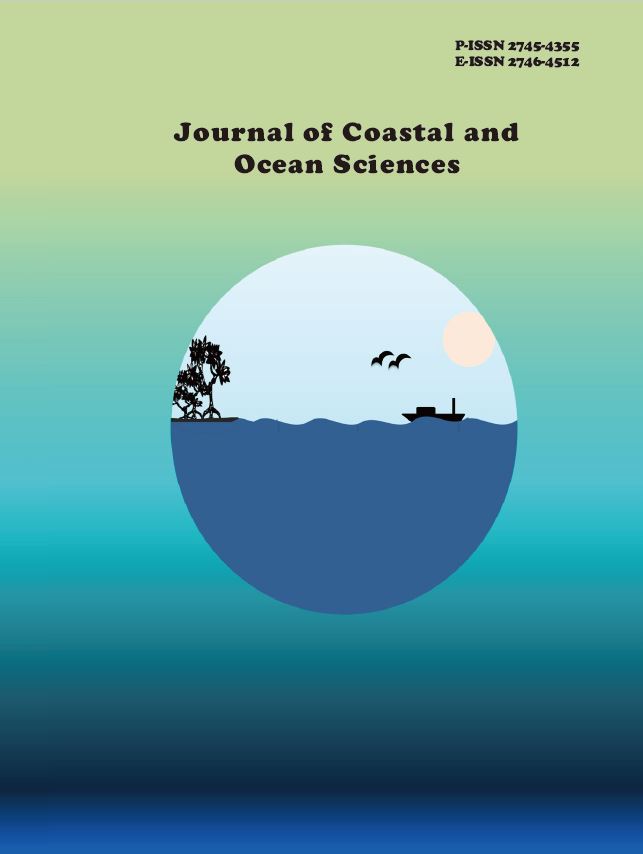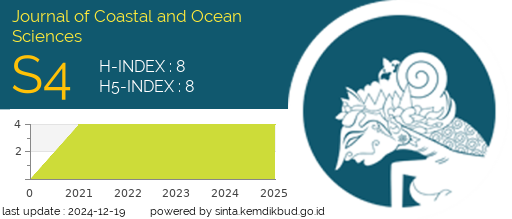Effect of Detergent Concentration and Exposure Duration on the Growth of Heterotrophic Bacteria in Seawater
DOI:
https://doi.org/10.31258/jocos.6.2.71-77Keywords:
Detergent, heterotrophic bacteria, concentration, exposure duration, seawaterAbstract
This research was conducted from June to July 2024 at the estuary of the Selat Morong River, Rupat District, Bengkalis Regency, Riau Province. This study aimed to examine the effect of different detergent concentrations on the growth of heterotrophic bacteria, as well as to investigate the influence of varying detergent exposure durations on their growth. The experimental method employed a two-factor completely randomized design (CRD) consisting of different detergent concentrations (Factor A) with five levels: A1 (0 ppm) as the control, A2 (3000 ppm), A3 (6000 ppm), A4 (9000 ppm), and A5 (12,000 ppm), and varying exposure durations (Factor B): 1 day, 6 days, 11 days, 16 days, and 21 days. The results showed that the logarithmic values of heterotrophic bacterial growth over the 21 days indicated the highest growth occurred on day 1 at a concentration of 0 ppm, with a value of 7.09 CFU/mL. However, bacterial growth declined over time, reaching its lowest point on day 11 at a concentration of 3000 ppm, with a value of 6.95 CFU/mL. Statistical analysis revealed that different concentrations and exposure durations had no statistically significant effect on the growth of heterotrophic bacteria (P>0.05), meaning that variations in detergent concentration and exposure time did not cause meaningful differences in bacterial growth under the experimental conditions. This study highlights the potential resistance of heterotrophic bacteria to detergent exposure. It provides a basis for further research into the resilience of microbial communities in marine environments affected by pollution.
Downloads
References
Achmad, R. (2004). Kimia Lingkungan. Edisi 1, 15-16p.
Adithiya, D.S., Feliatra, F., & Tanjung, A. (2017). Using Bacteria Heterotrophic as an Anti-Bacterial Againts Pathogenic Bacteria Isolated from Sea Water in Dumai City, Riau Province. Faculty of Fisheries and Marine. Universitas Riau
Artati, A. Hurustiaty, H., & Armah, Z. (2018). Pola Resistensi Bakteri Staphylococcus sp. terhadap 5 Jenis Antibiotik pada Sampel Pus. Media Kesehatan Politeknik Kesehatan Makassar, 11(2): 60-64.
Carvalho, C.C., & Fernandes, P. (2010). Production of Metabolites as Bacterial Responses to the Marine Environment. Marine Drugs, 8(3): 705-727.
Flynn, D. (2003). Student Guide to SPSS. Barnard College Department of Biological Sciences.
Gunawati, R.M. (2002). Keberadaan Bakteri Probiotik dan Hubungannya dengan Karakteristik Kimia Air dalam Kondisi Laboratorium. Institut Pertanian Bogor.
Kristanto. P. (2004). Ekologi Industri. Penerbit Andi.Yogyakarta.
Kurnia, K., Sadi, N.H., & Jumianto, S. (2016). Isolasi Bakteri Heterotrof di Situ Cibuntu, Jawa Barat dan Karakterisasi Resistensi Asam dan Logam. Life Science, 5(1): 59-63.
Kusrini, K. (2022). Toksisitas Limbah Deterjen terhadap Mortalitas Ikan Kepala Timah (Aplocheilus pancax). Jurnal Edukasi Cendekia. 6 (1).
Lichtenberg, D., Ahyayauch, H., & Goni, F.M. (2013). The Mechanism of Detergent Solubilization of Lipid Bilayers. Biophysical Journal, 105(2): 289-299.
Megawati, I.A. (2015). Uji Toksisitas Detergen terhadap Ikan Nila (Orheochromis niloticus). Fakultas Ilmu Kelautan dan Perikanan Universitas Maritim Raja Ali Haji.
Nasrum, A. (2018). Uji Normalitas Data untuk Penelitian. Jayapangus Press Books, 117.
Pakpahan, R., Effendi, I., & Nursyirwani, N. (2017). Pengaruh Penambahan Deterjen Attack dengan Konsentrasi dan Lama Pendedahan Berbeda terhadap Pertumbuhan Bakteri Heterotrofik di dalam Air Laut. Fakultas Perikanan dan Kelautan. Universitas Riau. Pekanbaru.
Said, N.I. (2006). Penghilangan Deterjen dan Senyawa Organik dalam air Baku Air Minum dengan Proses Biofilter Ungun Tetap Tercelup. Jurnal Teknologi Lingkungan, 7 (1).
Tarigan, L.R.W.B., Muharni, M., & Verawaty, M. (2019). Uji Koliform dan Resistensi Escherichia coli terhadap Beberapa Antibiotik pada Sampel Air Sungai Sekanak di Kota Palembang. Prosiding Seminar Nasional Hari Air Dunia (104-14).
Waluyo, L. (2004). Mikrobiologi Umum. UMM Press. Malang.
Yudo, S. (2018). Kondisi Kualitas Air Sungai Ciliwung di Wilayah DKI Jakarta Ditinjau dari Paramater Organik, Amoniak, Fosfat, Deterjen dan Bakteri Escherichia coli. Jurnal Air Indonesia, 6 (1).
Downloads
Published
Issue
Section
License
Copyright (c) 2025 Muhammad Hafizh, Irwan Effendi, Zulkifli Zulkifli (Author)

This work is licensed under a Creative Commons Attribution 4.0 International License.





